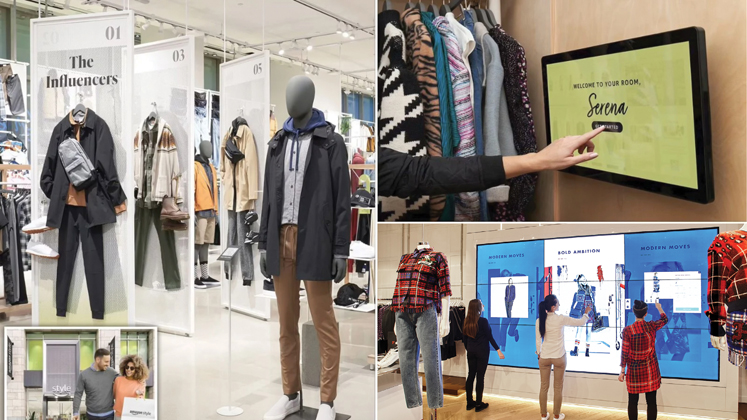Most experts have concluded that, contrary to popular belief, bricks-and-mortar retail is not destined to extinction. According to Crisil Ratings, bricks-and-mortar retail sales will grow by 20-25 per cent in the current fiscal year, driven by a strong recovery in demand. It is totally agreeable that retail stores will continue to exist because of their appeal to customers and the need for omnichannel shopping where they can easily switch between physical and digital spaces. But there is an important question circling around, about what the value proposition is going to be and how will it be like to shop at a store in 2040?
One irrefutable fact is that technology is the only way to climb the ladder, though it is an absolute expensive investment, and businesses are reluctant to experiment with something radically new, but they must be willing to adapt to current customer expectations and embrace new technology solutions to stay relevant in the retail market. Integrating technology leads to more sales; any retailer that does not change with the times will have more closed stores. Indian retailers need to think beyond the curve and adapt to technology as quickly as possible. WhatsApp for business and digital payments is like sunshine proving to retailers the convenience of the ongoing business due to technology. Integrating digital processes into the in-store experience is important because it often enhances the consumer shopping experience and facilitates the creation of innovative in-store experiences, which many believe is critical to increasing in-store traffic despite the rise of online retail. Retail stores in the future could transform into virtual reality theme parks that will delight every age group. This next phase of growth will be distinctive in that it will require a broader renewal of infrastructure and partnerships in the ecosystem.
Certainly, the pandemic has taught retailers a lesson: Bricks-and-mortar retailers need to restructure and diversify their presence to compete with emerging e-commerce. In the past year, 91 Squarefeet has worked with more than two dozen brands, including Tata, Aditya Birla Group and Reliance Retail, indicating that bricks-and-mortar stores are opening at a rapid pace even as consumers increasingly turn to online channels. Based on the criteria of convenience, ease and seamless shopping, artificial intelligence, machine learning and data analytics are already being used to improve the in-store customer experience, but only at a very preliminary level.
Amazon Go stores, for example, allow customers to easily pick up products without having to stop at the checkout (AI and cameras capture the transaction and bill the customer), increasing convenience. Other retailers and service providers are focusing on increasing perceived social presence. H&M has voice-activated interactive mirrors in its flagship store in New York City. If someone looks in the mirrors long enough, they ‘wake up’ and offer selfies, fashion tips and discounts. Another wonderful example is Amazon Style in Los Angeles, California, where customers simply scan an item’s QR code to see sizes, colours, general customer reviews and additional product details. Amazon Style offers more options and fits than a regular store, and also reduces the time it takes to find a suitable product.
In addition, companies like Arcteryx Equipments and Beauty Counter are using technology to enhance the customer experience and engage customers with their live streaming and powerful customer experience. Thanks to their impressive use of technology, both companies have consistently high traffic and sales.
Sneak peek at future
Future predictions for innovative bricks-and-mortar stores are sometimes beyond imagination
The evolution of retail from convenience to experiential is fuelled by digitisation. Over the next 15 to 20 years, the market predicts that two types of physical retail stores will dominate buying power: one is the extremely digitised Convenience Store and the other is the Experiential Centre with both serving as gold mines for data and customer insights.
Let us take a walk through the future convenience stores and experience centres, along with how technology can help retailers build a foundation for extravagant predictions.
If retailers want their stores to be a better experience for consumers, they have to embrace the ‘entertainment’ aspect of shopping. And that means having the ability to interact with consumers in highly relevant ways while they are in the store.
Scenario 1
Convenience stores in 2040: A store selling impulse and convenience goods, relying on deep technology and agile supply chain management
An exemplary shopper, let it be Joshua, wakes up to a message from his IoT-based smart closet that he needs a jacket for his planned trip to the icy Alps , hence plans to go to a nearby store. A voice-controlled robot welcomes Joshua to a nearby smart store, where connected IoT sensors are already collecting data about the jacket. When he enters the store, an augmented reality scanner collects data about his body measurements, including his skin and hair colour, and the store’s app directs him to the aisle where he can physically examine the NFC-tagged jacket.
Once he scans the tags, the app displays a range of colour options for the desired garment, along with care instructions and traceability details. Joshua selects the colour he wants and is immediately sent to a virtual fitting room, where he is shown other colour alternatives on an interactive screen. He clicks through his choices and can practically see in the dressing room mirrors which alternatives match his choice. He taps on the selection and receives the jacket in his dressing room. The jacket fits him exactly as the database contains his measurements, and he leaves the fitting room after approving the final purchase option by touching the garment tag with the NFC reader.
While he is in the store, his smartphone sends him messages about discounts and other offers. Later he arrives at the pickup location, taps his RFID chip-implanted palm to pick up his delivery, receives a notification about the total amount, and exits the store through cashless smart gates. Joshua now has a jacket of his size and desired colour without having to run around stores or sift through 20 pieces of merchandise to get the ideal one.
Retailers need to be future-ready
Scenario 1 clearly envisions the use of technology to gain consumer insights. Robots and automation technologies are making their way from factories to warehouses and distribution centres. The Internet of Things (IoT) is enabling millimetre-level tracking of items on different shelves. Now is an excellent time for retailers to address the issue of integrating technology and data in the offline world. Here could be some of the approaches:
- In-store cameras and smart sensors: Based on variables such as shopping trip distance, speed and the proportion of visits spent in various parts of the store, insights are gained, for example, unstructured refills are directly proportional to a long distance, whereas, ‘single purpose’ and ‘last-minute trips’ are proportional to high speed. More precise behavioural variations between segments can be sculpted out when combined with surveillance and sales data. Such information enables targeted recommendations for improving the shop layout, handling category management and its decisions related to squeezing more time from customers and their future
- Shelf monitoring and tracking technology: Smart shelves use a combination of proximity sensors, thermal imaging cameras, microphones, RFID tags, NFC, electronically printed labels, LED sensors and IOT sensors that are installed on shelves to monitor shelf inventory. The comprehensive product information, cross-selling ideas and key insights into customer preferences and buying habits help management make decisions about inventory, such as fast-moving items, slow-moving items, out-of-stocks, etc.
- Facial Emotion Recognition (FER): This is a system that analyses facial expressions in static photos and videos to obtain information about a person’s emotional state. When a consumer shows perplexity and leaves, the POS is notified in real-time. Thanks to this technology and data sharing, retailers will have information on how to improve their pricing, layout, assortment and customer experience.
- 5G Technology: 5G provides retailers with the connectivity they need to enable new technologies from digital signage to video identification of customers and more. 5G has the potential to deliver entirely new types of shopping experiences, such as an augmented reality app that activates when you enter a store and takes you directly to the shelf where you can find the goods you want.
Many Western retailers are experimenting with these technologies and beginning to see the benefits of a smart self-management system. In future, multiple technologies will merge to make the shopping experience profitable for both the customer and the store.
Scenario 2
Experiential Centres in 2040: Selling experiences focus on things that people think about more than purchasing products. The focus is on evaluating functionality and engaging customers with the brand.
Joshua recently attended a community meeting about outerwear and is now on his way to the experience centre. Oli, the voice-controlled robot, greets Joshua and informs him about what his shopping basket should look like today. He relies on facial recognition software that knows his shopping preferences and a list of products that might interest Joshua.
Joshua enters a booth with temperature control, so he can test whether or not the jacket will be useful in the upcoming weather. The booth scans the required measurements and asks him if he wants to customise the jacket. Joshua is then directed to a screen where he can select imprints for his jacket and read reviews from other customers around the world.
While his jacket is being customised, he looks at other products that are still in development but are made available for feedback on functionality. At the same time, he receives a notification about the recommended products in the centre which might interest him.
Even though he receives a pick-up delivery alert, he decides to stay longer in the store and have it delivered to his home via drone; within a few minutes, he receives a notification about delivery and completion of payment. While his jacket is being delivered, he explores other products, engages in discussions and even participates in live streaming at the centre.
Scenario 2 focuses more on how alive a customer should feel when they visit the physical store. The future of bricks-and-mortar retail will be to make people want to leave the house and go shopping. Concept stores will become more common, with less monetary transactions and more focus on a specific concept of a brand story. Combined with technology, it will be more about communicating the benefits of the product, which will lead to more sales and walk-in customers. As a result, we will be able to create a community where ideas are discussed, customer experiences are respected, new products are tested and events are held.
70 per cent of shoppers say ‘in-store experiences are important or very important’. The in-store experience will continue to be deeply engaging, making that transition from a transactional environment to an experiential and entertaining experience.
Predictions on experiential centres of future
1. Memorable and shareable in-store experience
Shopping will be viewed as a total experience, not just a trip to the store. Stores will have an enhanced feel for all products, synchronised with an omnichannel optimised backend network leading to transactions. Visual merchandising will play an important role in in-store design. Retailers will combine offline and online sales with branded apps. Branded apps will be a great way to achieve this; customers will use the app to make an appointment or even try on products before visiting the store. For example, they can connect their smartwatch to a kiosk in the store to see a product demonstration, get coupons or read reviews. The apps will feed information into the pipeline and extract useful data that can be used to increase sales through promotions.
2. End-to-end seamless flow
The future of checkout will undoubtedly change. There will be no more cash registers, no more lines and no more shoplifting. You’ll simply hold your phone’s barcode up to a sensor, grab what you need, and go – settlement will come via your wallet or cryptocurrencies. But that’s not all! By using the latest technology, the store will be able to detect a product that is not only on the shelves but also can be carried by hand, put in a pocket or even tucked under the shirt.
The future of bricks-and-mortar retail lies in a transformation that will see stores become the new face and personality of brands. Stores will become more interactive. It definitely won’t be ‘bricks-and-mortar’ the way that we know it, but ‘clicks-and-mortar’ in the new retail!
3. Seeing with augmented reality and virtual reality
Thanks to augmented reality, customers will have a fascinating experience while shopping in stores. For example, a customer in the dressing room at VR can find out which dress suits her without ever having worn it, and technology from AR will enhance matching looks, such as accessories and makeup. These stores will use augmented reality to make customer interactions easier and more exciting, increasing the shopping experience and sales.
4. Robotic AI-assisted sales people
We have become accustomed to chatbots in online stores, but as the line between online and offline becomes more blurred, we will see robots come to the rescue in physical stores. Retailers will use robots for inventory management, order retrieval, product customisation and customer service. Customers will benefit from a faster approach to selecting items through the use of voice-activated shopping assistants.
5. Hyper-individualisation of goods and services
Bricks-and-mortar retail will combine AI and AR/VR tools to design a unique garment for a customer that fits their exact body type by scanning and accessing previous data, as well as by customising for selection and occasion. It is easy to imagine that in the near future, we will be able to print such a customised garment directly in the store with a 4D printer leveraging personal customisation.
6. Blockchain and cryptocurrency
Companies using IoT sensor technologies will collaborate with retail stores to provide digital consumer data. Within a 200-metre radius of its IoT sensor, the system will be able to identify a human. The sensors will be able to detect cell phones as they pass through a store’s window or other location where a sensor is installed. This will allow partners to discreetly recognise visitors’ cell phones via the blockchain, enabling retail stores to securely identify customers as they enter. The plug-and-play module enables an omnichannel shopping experience for customers in stores. In essence, blockchain could be the operating system that allows retail to regain its prominence.
Imagine a world where the fluidity between online and offline is so seamless. We no longer think about them as separate channels. Store associates will understand customers well, access to inventory will be seamless regardless of where it’s located, and same-day delivery will be a standard.
Cryptocurrencies can streamline the transaction process. In fact, retail could be exactly what blockchain needs – a market where it could have an immediate and dramatic impact.
Sounds fantastic for now; however, ultimately, it all boils down to customers, because all retailers know is that satisfied customers is the best advertising strategy. Future will be a bit tricky to pull Generation Alpha out of the digital zone. However, hopes are high because Generation Z and Generation Alpha will be on a greater mission to explore all aspects of omnichannel the brands have to offer and will witness a magnificent transformation of ordinary bricks-and-mortar into a physical store that is a combination of showroom, gallery, community centre and arena of concierge services.









